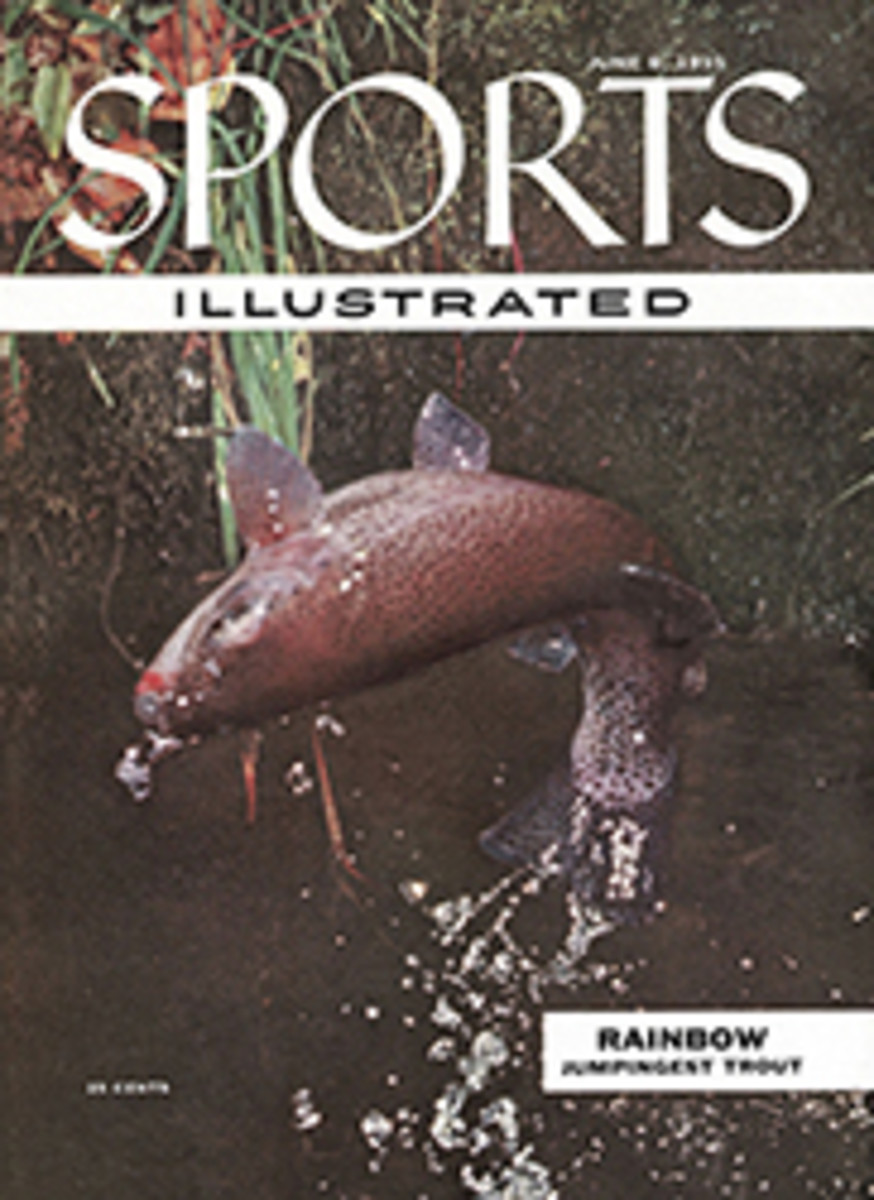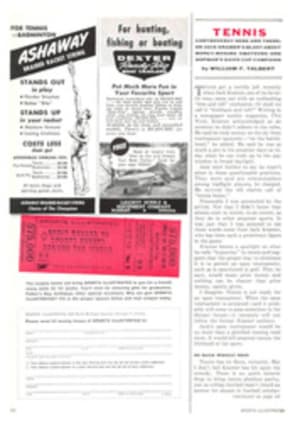
TRACK
Long before Sohrab and his mighty father Rustum fought their memorable battle on the sands of Oxus, the javelin, or spear, was an instrument of sports and an implement of war. For distance throwing it was blunted and capped with metal. But when it was thrown at a target—man or beast—the point was sharp. With the advent of gunpowder it became antiquated in battle and a forgotten sport.
The javelin throw is a Johnny come lately to the modern sports scene. It did not become an Olympic event until 1906, an event in the national AAU championships in 1909. It was not included in IC4A competition until 1922. Many high schools in the U.S. still do not include it in dual track meets.
Most of us believed that the Finns and the Swedes were born to be javelin throwers; that a thousand years of ancestors hunting with spears amid the deep forests and lakes had developed a special breed. Certainly there was reason to think this. From the start the Swedes dominated the event, when Eric Lemming won it in three Olympics. Then along came Jonni Myyra of Finland in 1915 with his throw-on-the-run method, and the Finns remained supreme until Cy Young of the U.S. (no relation to the great old-time pitcher) won the 1952 Olympics with a heave of 242 feet 0.78 inches. Myyra beyond question must be recognized as the father of the modern javelin throw and the founder of a dynasty which includes such great performers as Matti Jarvinen, Julius Saaristo, Eino Penttila and Kaj T. Rautavaara.
For many years American competitors were so far behind these foreign performers that there was no interest in the event on this side of the Atlantic. In 1909 the supergiant Ralph Rose, holder of the world's record in the shot-put, established the first national mark in the javelin with a measly throw of 141.7 feet. Most any high school boy can better that mark now with a few weeks' practice. The early American competitors were simply "throwers" without any idea of technique. They would run up to the line, hop, stop and throw. The momentum of the approach run was lost, and there was nothing but "arm" in the throw.
A CHALLENGE TO THE MASTERS
Our track coaches were slow to adopt the. Finnish throw-on-the-run technique. It was not until 1930 that an American, Jim DeMers of the University of Oregon, broke ground past the 220-foot mark. Then came an era of study by slow-motion pictures of the Finnish form and the importation of the Karhu javelin from Finland. Our American performers started challenging the old masters of the Myyra school. Their efforts were climaxed by Clarence (Bud) Held, formerly of Stanford and now an ordained Presbyterian minister, who established the presently accepted world's record at 263 feet 10 inches on August 8, 1953. To add insult to injury, he did it not with the famous Karhu but with a home-made javelin which is now being manufactured commercially by Held's father and brother near San Diego. (Held himself is not connected with the firm because that would endanger his amateur standing.)
It was not until August 1954, a year later, that the International Federation formally approved the record made with Held's javelin. There was, for one thing, considerable discussion because the javelin point did not stick. Most observers agree that it did hit but bounced off because of the hard ground. Anyway, there is nothing in the rules about sticking. The point must simply hit the ground first to make it a legal throw.
As for Held's javelin, there was nothing illegal in its construction. Held cut off the front 17 centimeters (6¾ inches) of the 37-centimeter (14½-inch) weighted steel tip and welded the remaining 20 centimeters into a blunt tip. To maintain the minimum weight requirement (1.76 pounds, or 800 grams), he replaced the slender wooden shaft between the cord grip and the tip with the thick middle section of the javelin which was glued into place. It is much fatter from tail to point than the Karhu, has less steel and more wood but still maintains the center-of-gravity point at less than the legal limit of 3 feet 7½ inches (110 centimeters) from the tip.
The theory of the construction behind the Held design is to have the balance so arranged as to keep the point up for the maximum distance in flight. Sounds simple and elementary, but Bud thought of it first.
"Each javelin has a personality," says Held. He prefers a stiffer shaft than most competitors. He has sharpened the shortened steel tip from his earlier models, saying that he just didn't have the equipment at the beginning. At Modesto, California on May 21 this year he twice sent the spear past his old mark and on the final throw set a mark of 268 feet 2½ inches. Incidentally, the javelin he used at Modesto was made of spruce, which is lighter than the usual birch.
There was some doubt in the minds of certain members of the International Federation as to whether Held's original record should be accepted because it was made with an "exclusive product" not available to other competitors. Since those days Bud has taken several javelins around to each of the meets for general use. There have been less than 200 made so far (price: $18 to $26) by his father and brother.
THE REVOLUTION IS ON
Cy Young, the Olympic champion, Bill Miller, Leo Long and Bob Kimball are using the Held-style javelin and are all hovering around the 240-foot mark at the present time. So far none has been shipped out of this country. Managing Director Rolf Hohenthal of the Finnish firm Sportarticles Co. Ltd., whose trademark is the Karhu, is following Bud Held's progress and javelins with interest. Last year the "new look" Karhu had only a 22-centimeter tip attached to the birch shaft, so the revolution is on. Hohenthal thinks that the only difference between the Held javelin and the Karhu is that the former are tailormade in single units, and that they will fly no better than Karhu's latest. But you've got to have men as well as javelins to win, and the fall of '56 will come around real soon.
The 27-year-old, 6-foot 1-inch, 167-pound Held had an in-and-out year in 1954 experimenting with new forms. He is now reconverted to the Finnish form and feels he is throwing better than ever. His ambition—not his prediction—is 280 feet. He plans to be in top form for the Pacific Coast AAU championship at Stockton on June 10. More power to you, Preacher.
ILLUSTRATION
STEP BY STEP THROUGH THE FINNISH FORM
START
Check 1
FIVE STRIDES
20 to 25 feet
Run at half speed
L
R
L
R
L
Check 2
EIGHT STRIDES
47 to 49 feet
Run close to top speed
R
L
R
L
R
L
R
L
Check 3
30 to 34 feet
R-1
L-2
R-3
L-4
R-5
SCRATCH LINE
13 ft. 1½ in.
Key to the finish from is final sequence of six steps, which allows javelin thrower to hurl it while fully utilizing momentum of his run. As left foot hits Check 3, he is running with javelin poised high. On step R-1 he turns right foot slightly outward and starts to bring javelin back. At step L-2 he is half turned to right. At step R-3 thrower's right foot is parallel to the scratch line, javelin is fully back and body leaning back at 40° angle. From this position he throws with full momentum of his forward motion off right foot, landing on left foot, which points straight ahead, and crossing right foot over to stop at line.

